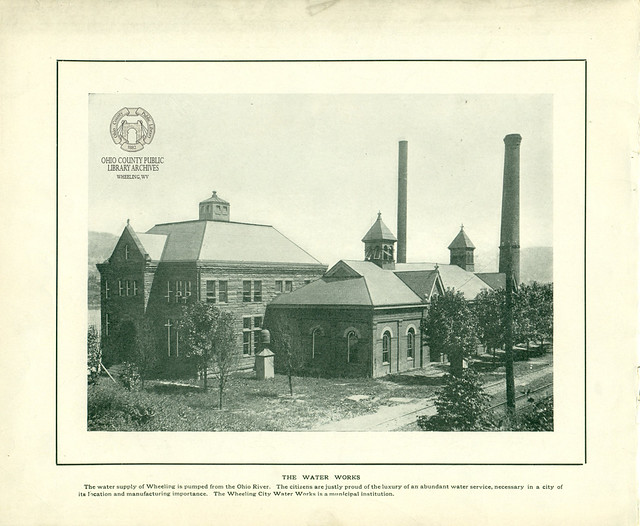Wheeling Water Works
-from the National Register of Historic Places Registration Form for the North Wheeling Historic District, 1988.
A major development occurred in North Wheeling in the early 1830's which was a significant aid in the growth of the Wheeling area. The Wheeling water system was designed, built, and put into operation on August 16, 1834. The system predated water works in New York City and Boston.
The system was certainly not sophisticated. It supplied raw unfiltered water to city customers from a reservoir which was filled by a steam powered pump. The stone reservoir had a capacity of 500,000 gallons and water was delivered from pump to reservoir to customers by means of cast iron pipe. The cast iron was available because of the many foundries in the Wheeling area, Most cities used wooden pipes (hollow logs) for their early water systems. Wooden pipes were neither durable nor water tight. The fourteen-inch main from the pump to the elevated reservoir was still in use in 1966, 132 years after first being put into service.
The water works was located in the district with the pump house located at the bottom of Eighth Street and the reservoir located between Seventh and Eighth Streets just east of Lane C. Improvements in 1884 and 1889 consisted of another building, and a much larger 3,000,000 gallon stone reservoir was built further up Wheeling Hill.
Around the turn of the 20th century, land was purchased for a new water works a few miles north, up the river, from the old water works location. At the turn of the 20th century, three pumps and two buildings serviced the works. Between 1911 and 1913, a pumping station designed by Wheeling architect Frederick F. Faris was added. It housed a pump that was advertised to have, at 110 inches in diameter, the largest steam piston in the world at that time. This pumping station is the only building that is still standing today.
Locations
▶ The original Wheeling Water Works stood at the foot of 8th Street in North Wheeling (on the river side of the the rail road tracks, now Wheeling Heritage Trail, at the base of 8th Street). Around the turn of the 20th century, the works moved three miles north to a location on River Road.
Images

Additional Resources

